MSI X48 Platinum: Four PCI Express x16 Slots to go Please....
by Kris Boughton on January 31, 2008 7:15 AM EST- Posted in
- Motherboards
Board Features and Layout (Continued)
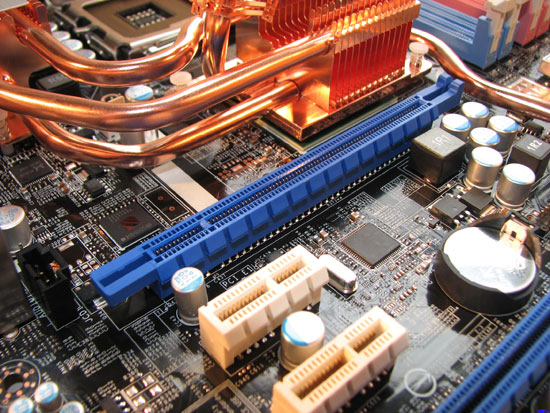
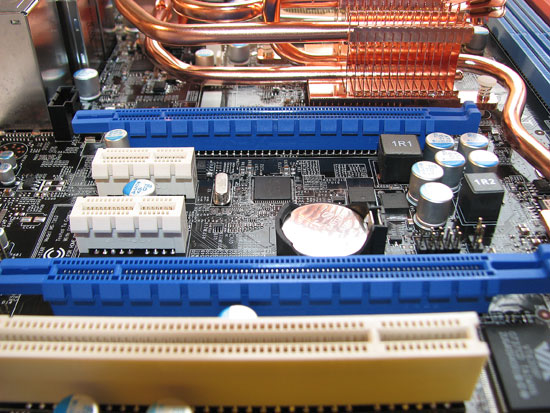
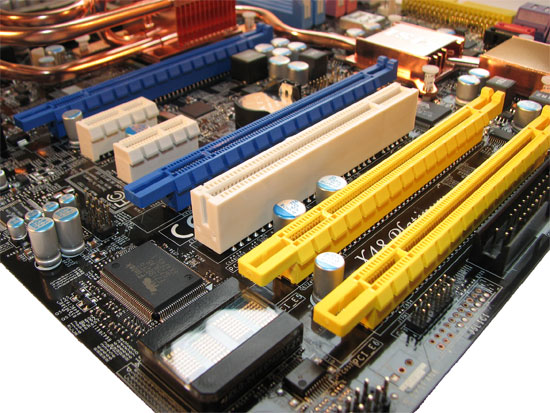
In a surprising twist of events MSI has opted to design the X48 Platinum to allow for a total of four x16 PCI-Express cards to be installed simultaneously, making this board rather unique in this respect. The blue slots are directly connected to the X48 MCH, making them PCI-E 2.0 compatible and the right choice when configuring the system for standard CrossFire operation. The bottom two yellow slots are able to accept x16 cards mechanically, but each only provides for x4 link speeds from the installed device to the Southbridge.
This particular PCI Express expansion topology is different than some other X48 boards with only one additional PCI-E x16 (x4 electrical) slot hanging off of the ICH9R. MSI does this by adding a third-party chip to the X48 Platinum which bridges one of the available PCI-E x1 lanes offered by the ICH to an x4 electrical link state which is seen by the lower yellow PCI-E slot. One could argue that the performance potential of such a setup is marginal at best seeing as how the device installed in the last PCI Express slot is seriously bottlenecked by this configuration. Although the slot device is configured for x4 operation, the bridge chip is only able to communicate with the ICH at x1 speeds. Furthermore, this downstream device must contend with all other PCI Express traffic passing through the ICH to the MCH over a single x4 link, which would most likely include another x4 device residing in the first yellow slot. However, regardless of the shortcomings we may note, the additional capabilities provided by this setup are clear: many x16 devices are only capable of down-training to speeds of x4 or x8 and without this bridge chip the last x1 lane would be otherwise useless.
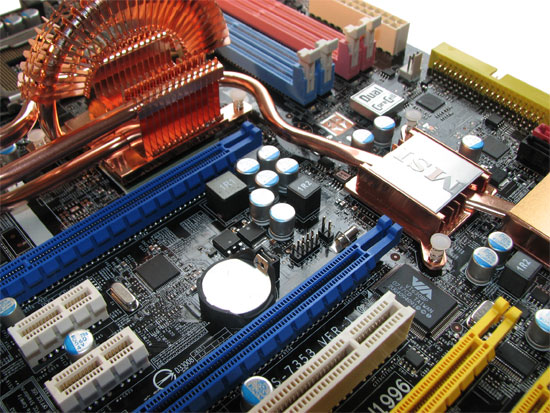
Seeing as how MSI has managed to provide this extra feature while still keeping the overall board cost low, we can hardly fault them for trying to do right. The dual PCI-E 2.0 x16 lanes by themselves provide more than enough transfer bandwidth for even the most data-hungry video cards. ATI's newly release Radeon 3870X2 is already a dual-CrossFire setup on one card - adding a second card to the other primary graphics slot brings the potential of quad-CrossFire action (drivers pending). Because of this we believe it is safe to assume that any cards that find home in the yellow slots will most likely be more forgiving when it comes to interrupts in maximum throughput or associated latencies. For example, this board makes possible the option to install an additional card for physics as well as a PCI-E disk controller card that requires more than a single x1 link to operate. This alone is almost enough for us to consider the X48 Platinum as a strong candidate for a workstation motherboard.
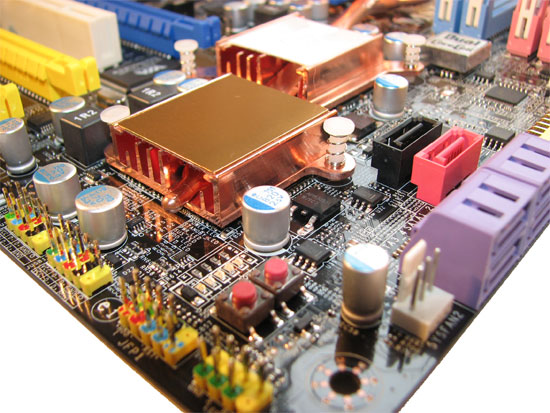
Here is a better look at the heatsink covering the third-party bridge chip we previously mentioned. We can also see four of the six SATA ports attached to the Intel ICH9R Southbridge. The remaining two ports provided by the ICH are located on the motherboard's back panel as eSATA connections, giving the user the ability to run an external RAID array without the need for any additional hardware. The last two remaining ports - one black, one red - are attached to the add-on Marvell controller and support JBOD and RAID 0/1 configurations.
Onboard power and reset buttons are provided for the user than wants to control their board without the use of a chassis, and an array of status lights can be seen just to these left of these, removing the need for a case altogether.










21 Comments
View All Comments
taylormills - Monday, February 4, 2008 - link
Hi all,Just a newbie question.
Does this indicate that sound cards will be moving to PCI Express.
Just curious because I have an older Board and am going to want to upgrade and I find it hard to fit a sound card around my twin 8800 boards. Due to them taking up the available slots.
Any info ?
karthikrg - Saturday, February 2, 2008 - link
how many ppl are using even crossfire 2x let alone think about crossfire 4x? 4 pcie slots IMHO is overkill. hope amd at least delivers crossfire x drivers in time. else it'll all be an utter waste.ninjit - Friday, February 1, 2008 - link
At the beginning of the article you mention that this is a DDR3 board, yet in the specifications chart you have lines for:[quote] DDR2 Memory Dividers [/quote]
&
[quote] Regular Unbuffered, non-ECC DDR2 Memory to 8GB total [/quote]
nubie - Friday, February 1, 2008 - link
"many x16 devices are only capable of down-training to speeds of x4 or x8 and without this bridge chip the last x1 lane would be otherwise useless." This does interest me, I have had 3 nvidia cards (2x6600GT and 6200) running on a plain jane MSI neo4 OEM (Fujitsu Seimens bios), simply by cutting the ($25) 6200 down to a x1 connector and cutting the back out of one of the motherboard x1 slots to allow the 6600GT to fit physically.I thought that part of the PCIe standard was auto-negotiation, wouldn't any device NOT compatible with x1 be breaking the standard?
http://picasaweb.google.com/nubie07/PCIEX1/photo#5...">http://picasaweb.google.com/nubie07/PCIEX1/photo#5...
I am very curious about this, as the PCIe technology doesn't seem to be getting as much use as it could(IE it is MUCH more flexible than it is given credit for). The PCIe scaling analysis at Tomshardware showed that an 8800GTS was still quite capable at x8, so on PCIe 2.0 a x4 slot could be used for gaming at acceptable resolutions! (I am fully aware that only the first 2 slots are PCIe 2.0)
The new Radeon "X2" card with 4 outputs could fit in this motherboard 3 times over, that is 12 displays on 1 PC with off-the-shelf technology!! With the quad-core and 12 displays, 2 PCs at around ~$1,000-$3,000 apiece could service a whole classroom of kids using learning software, typing tutor programs, or browsing the web. Even with regular old 2 output video cards you could get 8 displays on a much cheaper rig with sub-$50 video cards. So I wouldn't say "the performance potential of such a setup is marginal", unless I was measuring performance in such meaningless terms as how many $xxx video cards I can jam in a PC to get xx% increase.
kjboughton - Friday, February 1, 2008 - link
You are correct when you say that PCIe devices are capable of auto-negotiating their link speeds; however, not all devices will allow for negotiated speeds of only x1. This includes most video cards, which will allow themselves to train to x16, x8, and x4 speeds but not x1. They are flexible to the extent possible, but nowhere does the PCIe specification require that that all devices support all speeds...after all, cards that make use of an x8 mechanical interface are obviously incapable of x16 speeds, too...smeister - Friday, February 1, 2008 - link
What's with the memory reference voltage?On the specification page (pg 2)
Memory Reference Voltage Auto, 0.90V ~ 1.25V
It should be half the DDR3 memory voltage
1.5V x 0.5 = 0.75V, so should be: Auto, 0.75V ~ 1.25V
kjboughton - Friday, February 1, 2008 - link
If you want half of 1.50V then leave it on 'Auto'...regardless, the lowest manually selectable value is 0.90V.DBissett - Thursday, January 31, 2008 - link
I can't find it now, but a couple of days ago I found this X48 board listed on MSI's website along with an X48C which would take either DDR3 or DDR2. Would be great to be able to use it now with DDR2 and upgrade to DDR3 when the prices get sane and it becomes clear why DDR3 is better.Dave
feraltoad - Thursday, January 31, 2008 - link
almost always recommend replacing the thermal interface material (TIM)You state to replace teh TIM for the PWM and Chipset heatpipe coolers. I have a question regarding that. I have a IP35 pro, and I bought a new case. I thought now might be a good time to replace my pushpins with bolts, but I am hesitant about removing the thermal pad. I know that a direct contact to the heatpipe cooling system will result in better heat transfer, but I am afraid of shorting something out. Is it safe to have the cooler setting directly on the PWM? Does the pad also function as an insulator? I can live with a bit higher temps, but I can't live with killing my MOBO. Anyone's comments with some experience on this would be greatly appreciated.
ButterFlyEffect78 - Thursday, January 31, 2008 - link
I get 9631mb/s on my Nvidia EVGA 680i chipset at only 750mhz ddr2 with 4-4-3-5 1T.And my brother who owns an Intel P35 Foxconn Mars board gets 9132mb/sec at 950mhz ddr2 with 5-5-5-18 2t.
So what is the point on moving to ddr3 when it offers no performance gains in memory bandwidth even at a whopping 1600mhz. Is it just me who thinks Cas7 is wayyyy too high to even consider to push ddr3 to the market right now?
I believe this is what only Intel wants so it can make AMD look old just like how they forced AMD a few years ago to make AM2 boards that only supported dd2.